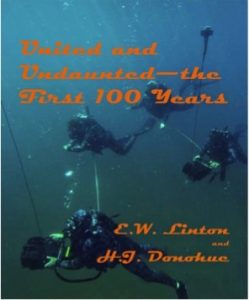- Author
- Book reviewer
- Subjects
- RAN operations
- Tags
-
- RAN Ships
- None noted.
- Publication
- June 2016 edition of the Naval Historical Review (all rights reserved)
United and Undaunted – the First 100 Years 1911-2011, by E. W. Linton and H. J. Donohue. Grinkle Press, Canberra, 2015. 376 pages, illustrated, with appendices and index. Cost $70 including post and packaging.

In 1976 the Naval Historical Society of Australia published United and Undaunted: the History of the Clearance Diving Branch of the RAN. Authored by the late Ross Blue, who was himself a Mine warfare and Clearance Diving Officer (MCDO), the short monograph was released to mark the 25th anniversary of the creation of the branch. Forty years later, it is pleasing to see that Commander Jake Linton and Commodore Hec Donohue have decided to not only fill the gaps in the earlier account, but also to bring the story up to date. Well experienced in the subject, the two authors offer up a fascinating and authoritative account that delves deeply into a world that only a select few professionals can inhabit.
Diving in the RAN has a long history, with most ships possessing at least some capability but, as the authors point out, the diver’s role has expanded considerably over the years. From an underwater worker, responsible for limited underwater inspection, maintenance and repair, the clearance diver has transformed into a highly specialised mine warfare expert, EOD technician and covert operator, vital to many different facets of modern maritime operations.
In 25 chapters the authors cover both triumph and tragedy. Mostly the former, but as the book’s dedication reminds us, no fewer than 28 divers have lost their lives during their RAN service. Noteworthy is the fact that the last fatal diving accident occurred in 1983, representing an excellent safety record given the inherent risks of underwater work and the tempo and diversity of operations since that date.
The first half of the book largely deals with the pre-Vietnam era, but with sections on broader topics such as diving teams, aircraft and ship salvage, training schools and the school of underwater medicine. After a chapter on the operations of Clearance Diving Team 3 in Vietnam from 1966 to 1971 (Jake Linton deployed as commander of the 8th contingent), the remainder of the book offers a unique and important perspective on more recent ADF operations. Few Australians, for example, would appreciate that the RAN’s clearance divers have regularly deployed into Afghanistan where their professional skills proved vital in countering the threat posed by improvised explosive devices (IED). In addition to training, disposal and exploitation, on occasion RAN MCDOs have accompanied coalition special forces on missions to directly disrupt insurgent IED operations.
The book includes many colour and black and white illustrations from both official and private sources. The latter pictures, combined with personal accounts, are a real strength of the book. Like many who have served, getting a member of the Clearance Diving community to talk is hard enough, but convincing them to write it down is another matter entirely. That the authors are themselves highly respected members of the community has undoubtedly helped in this regard, and gives the narrative the credibility it deserves.
The main text is complemented by a number of useful appendices that provide more detailed information on equipment, honours and awards, and significant personnel. There is also a list of acronyms, without which many a lay reader might find themselves lost.
As the foreword by Vice Admiral Russ Crane (MCDO and former Chief of Navy), reminds us, the operating environment of the clearance diver is one of the most dangerous and challenging a person can encounter, but this book ‘graphically demonstrates the growing utility, strategic appreciation and value of the role of the highly trained and skilled Clearance Diver’. This reviewer can only agree, and by offering a window into their secretive world, this book is highly recommended.
Reviewed by David Stevens
Perfect bound copies of United and Undaunted may be obtained from Jake Linton linton@bigpond.net.au. Profits from sales support the Naval Clearance Divers Association and the Naval Clearance Diver Trust.




